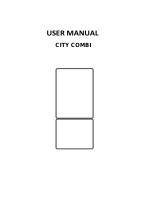10
by such factors as the location of refrigerating
appliance, ambient temperature, and
frequency of door open, etc., and if
appropriate, a warning that setting of any
temperature control device might have to be
varied to allow for these factors should be
made.
⚫ Effervescent drinks should not be stored in
the freezer compartment or the low-
temperature compartment, and some
products such as water ices should not be
consumed too cold.
Food storage location
Due to the cold air circulation in the refrigerator,
the temperature of each area in the refrigerator is
different, so different kinds of food should be
placed in different areas.
The fresh food compartment is suitable for the
storage of such foods as need not to be frozen, the
cooked food, beer, eggs, some condiments that
need cold preservation, milk, fruit juice, etc. The
crisper box is suitable for the preservation of
vegetables, fruits, etc.
The freezer compartment is suitable for the
storage of ice cream, frozen food and the foods to
be preserved for a long time.
Use of the fresh food compartment
Set the temperature of the fresh food storage
compartment between 2 ℃ ~ 8 ℃, and store the
foods that are intended for short-term storage, or
to be eaten at any time in the fresh food
compartment.
Fridge shelf: When removing the shelf, lift it up
first, and then pull it out; and when installing the
shelf, place it into position before putting it down.
(For the two-section shelf, push the first section to
the rear end, and then pull the second section out).
Keep the shelf rear flange upward, to prevent
foods from contact the liner wall. When taking out
or putting in the shelf, hold it firmly, and handle
with care to avoid damage.
Crisper box: Pull out the crisper box for access to
food. After using or cleaning the cover plate of the
crisper box, be sure to put it back onto the crisper,
so that the internal temperature of the crisper box
will not be affected.
Cautions for food storage
You’d better clean the foods and wipe them dry
before storing them inside the refrigerator.
Before foods are put in the refrigerator, it is
advisable to seal them up, so as to prevent water
evaporation to keep fresh fruits and vegetables
on one hand, and prevent taint of odor on the
other hand.
Do not put too many or too weight foods inside
the refrigerator. Keep enough space between
foods; if too close, the cold air flow will be blocked,
thus affecting the refrigeration effect. Do not
store excessive or overweight foods, to avoid the
shelf from being crushed. When storing the foods,
keep a distance away from the inner wall; and do
not place the water-rich foods too close to the
fridge rear wall, lest they get frozen on the inner
wall.
Categorized storage of foods:Foods should be
stored by category, with the foods you eat every
day placed in front of the shelf, so that the door
open duration can be shortened and food
spoilage due to expiration can be avoid.
Energy-saving tips: Allow the hot food cool
down to the room temperature before putting it
in the refrigerator. Put the frozen food in the fresh
food compartment to thaw, using the low
temperature of the frozen food to cool the fresh
food, thus saving energy.
Storage of fruits and vegetables
In the case of refrigerating appliances with chill
compartment, a statement to the effect that some
types of fresh vegetables and fruits are sensitive
to cold and therefore are not suitable for storage
in this kind of compartment should be made.
Use of the frozen food storage compartment
The freezer temperature is controlled below -
18 ℃, and it is advisable to store the food for long-
term preservation in the freezer compartment,
but the storage duration indicated on the food
packaging should be adhered to.
The freezer drawers are used to store food that
needs to be frozen. Fish and meat of large block
size should be cut into small pieces and packed
into fresh-keeping bags before they are evenly
distributed inside the freezer drawers.
★ Allow the hot foods to cool down to the room
temperature before putting them in the freezer
compartment.
★Do not put a glass container with liquid or the
canned liquid that is sealed in the freezer
compartment, so as to avoid burst due to volume
expansion after the liquid gets frozen up.
★Divide the food into appropriately small
portions
★You’d better pack the food up before freezing it,
and the packing bag used should be dry, in case
the packing bags are frozen together. Foods
should be packed or covered by such suitable
materials as are firm, tasteless, impervious to air
and water, non-toxic and pollution-free, to avoid
cross-contamination and transfer of odor.




















